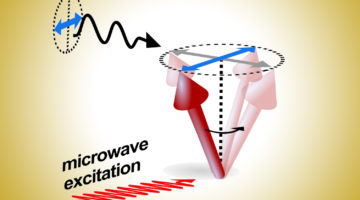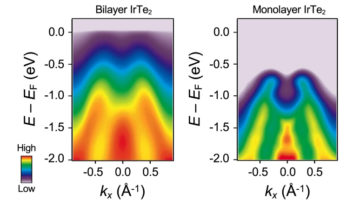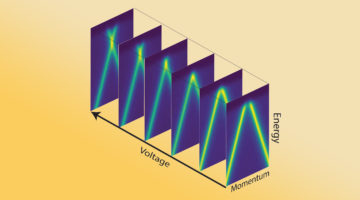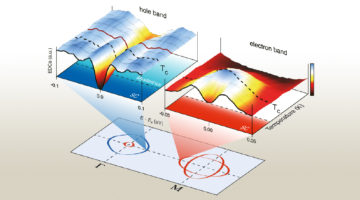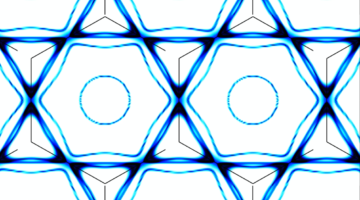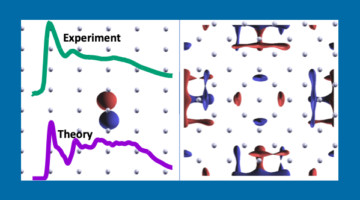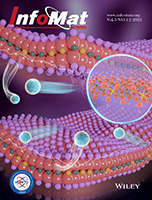Researchers developed a technique that enables time-resolved, direct detection of spin currents in either ferromagnetic or antiferromagnetic materials at GHz frequencies. Studying the dynamic properties of antiferromagnetic spintronic effects could lead to greater stability and faster intrinsic switching speeds compared to conventional spintronics. Read more »
ALS Work Using Spectroscopy
These techniques are used to study the energies of particles that are emitted or absorbed by samples that are exposed to the light-source beam and are commonly used to determine the characteristics of chemical bonding and electron motion.
A Novel Insulating State Emerges in a 2D Material
Researchers found a unique insulating state in an atomically thin material, driven by the combined effects of lattice–charge interactions and atomic-bond formation. The work provides a better understanding of charge ordering in two-dimensional materials and opens up new possibilities for achieving designer electronic properties. Read more »![]()
![]()
What Drives Electron–Hole Asymmetry in Graphene?
Using the ALS, researchers determined that interactions between electrons are what give rise to the divergent effects observed when graphene is doped with electrons versus holes. A better understanding of this electron–hole asymmetry could lead to new avenues for generating exotic material phases, including unconventional superconductivity. Read more »![]()
![]()
Scientists Uncover Surprising New Clues to Exotic Superconductors’ Superpowers
Researchers studied a model material (CeCoIn5) that mimics a cuprate superconductor that can be switched on and off using high magnetic fields. In chemical compositions where the superconductivity is strongest, the number of free electrons jumps, signifying a transition point. The researchers attributed this transition to the behavior of electrons associated with the cerium atoms. Read more »
A Photoelectrode Protection Scheme for Solar-Fuel Production
Microscopy, spectroscopy, and computational studies of a promising artificial-photosynthesis material led researchers to develop a model photoelectrochemical (PEC) cell with remarkable stability and longevity as it selectively converts sunlight and carbon dioxide into two promising sources of renewable fuels—ethylene and hydrogen. Read more »
Interlayer Coupling Drives Mysterious Phase Transition
Researchers found that a mysterious phase transition in an iron-based superconductor is driven by interactions between the material’s 2D layers. The results counter the assumption that interlayer coupling is negligible in such materials, suggesting instead that the interactions can be an effective way to tune superconductivity. Read more »![]()
![]()
Scientists Discover ‘Secret Sauce’ Behind Exotic Properties of New Quantum Material
Kagome metals have long mystified scientists for their ability to exhibit collective behavior when cooled below room temperature. A research team has discovered that the kagome electrons’ unusual synchronicity is due to another behavior known as an electronic singularity, or the Van Hove singularity, which involves the relationship between the electrons’ energy and velocity. Read more »
Revealing Lithium Metal’s Electronic Structure
Spectroscopy at the ALS and theoretical calculations at the Molecular Foundry revealed the intrinsic spectroscopic signature of lithium metal and explained the origin of previous contradictory reports. The findings provide a benchmark for further studies of lithium compounds towards batteries with higher capacity and energy density. Read more »![]()
![]()
Synthesis of new two-dimensional titanium carbonitride Ti2C0.5N0.5Tx MXene and its performance as an electrode material for sodium-ion battery
Researchers report on the synthesis and characterization of a new 2D carbonitride MXene, Ti2C0.5N0.5. They explore the performance of this new MXene as electrode materials for sodium-ion batteries (SIBs). It outperformed its carbide counterpart (i.e., Ti2C) and all the other reports for multilayer MXenes in SIBs, and it showed a stable electrochemical performance over 500 cycles. Read more »
New Device Advances Commercial Viability of Solar Fuels
A Berkeley Lab research team developed a new artificial photosynthesis device component that exhibits remarkable stability and longevity as it selectively converts sunlight and carbon dioxide into two promising sources of renewable fuels—ethylene and hydrogen. Read more »
- « Previous Page
- 1
- …
- 8
- 9
- 10
- 11
- 12
- …
- 30
- Next Page »
